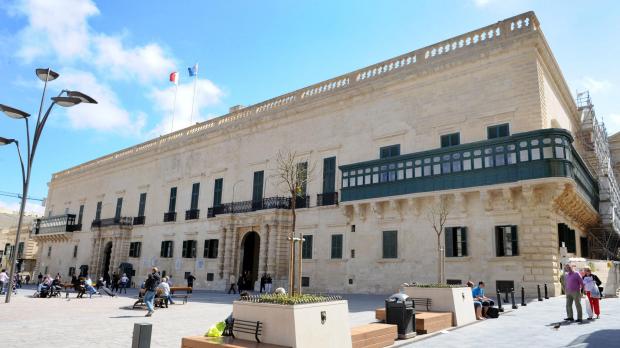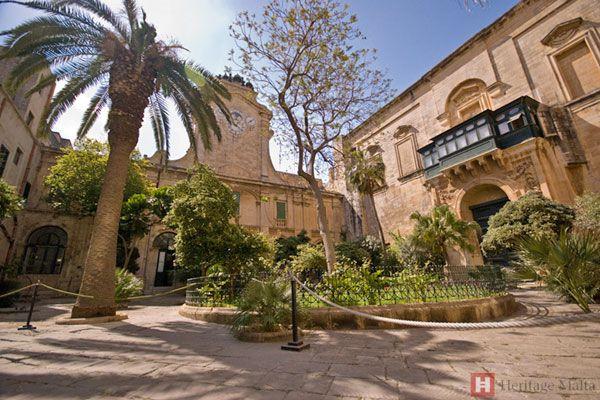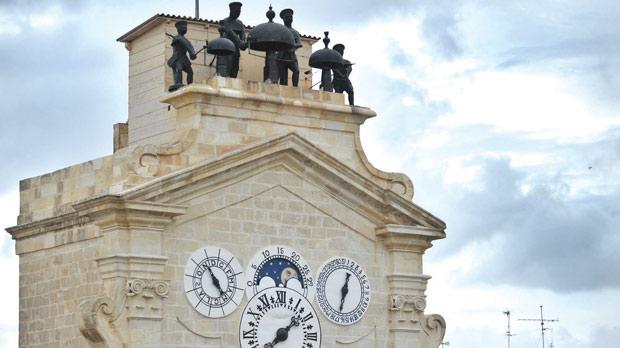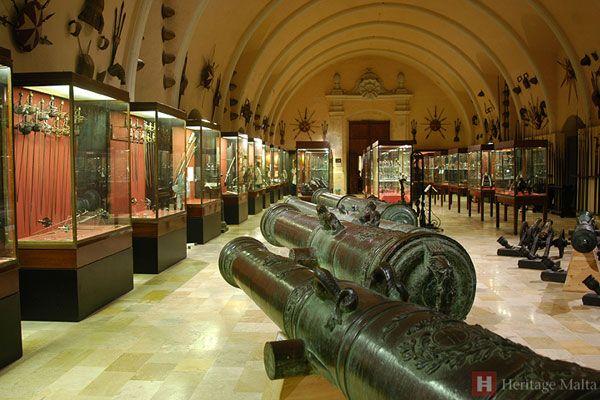The Grandmaster’s Palace (officially referred to as The Palace) is located in Valletta. It currently houses the Office of the President of Malta as well as being a heritage site run by Heritage Malta. Up to April 2015 it also housed the House of the Representatives until Parliament moved in May 2015 to its first purposely built building at the Valletta Entrance. 


Brief History
The original building was the house of Eustachio del Monte, a nephew of Grandmaster Jean de la Vallette, founder of the city. This house was situated on the corner of Strada San Giorgio (now Republic Street) with Strada del Salvatore (now Old Theatre Street). This house was purchased together with the adjacent houses facing Strada San Giorgio and on Strada San Giacomo (now Merchants Street). On the corner of Strada San Giorgio and Strada del Popolo (now Archbishop Street) there was the Auberge d’Italie. The Auberge was built in 1570 on the design of Girolamo Cassar. All these buildings were purchased by Grandmaster Pietro del Monte and Girolamo Cassar was commissioned to design a palace. The Palace was erected between 1571 and 1580. Over the years, the Palace was enlarged and developed by successive Grandmasters to serve as their official residence.
Grandmaster Pinto was responsible for various alterations to the Grand Master’s Palace. Gerolamo Cassar’s austere façade was embellished by the addition of two Baroque gateways with both the arched entrance portals being flanked by banded hardstone columns and with the overlying Doric entablature supporting an open wrought iron balcony. Other interventions included a second main entrance to the palace courtyard from old Theatre Street and the impressive closed timber balconies that wrap around the palace facades. The balconies are supported by stone corbels which are decorated with stucco work and escutcheons of Grandmasters. In 1745, Pinto commissioned the construction of an ornate clock that was placed on one side of Prince Alfred’s courtyard. The Pinto clock carries four bronze figures representing Moorish slaves holding hammers which shift sideways when striking the gongs. The weights of the clock are contained within the stone turret which is decorated by pilasters and volutes.
In the 18th-century, traveller Patrick Brydone noted that:
the Grand Master (who studies conveniency more than magnificence) is more comfortably and commodiously, lodged than any prince in Europe, the King of Sardenia perhaps only excepted.
During the British period it served as the Governor’s Palace. The Council of Government and the Malta Legislative Assembly (precursors to the present day House of Representatives) met here and it also was the first place to serve as the office of the Prime Minister.
Structure
The palace is built around two courtyards, one of which is dominated by a statue of Neptune. There are two entrances in the front and one entrance from Piazza Regina (Republic Square) just west of the National Library. The entrance to the state rooms is in the Neptune Courtyard via a spiral staircase. The ceiling of this entrance was painted by Nicolau Nasoni in 1724. The Armoury, housing one of the finest collections of weapons of the period of the Knights of Malta, runs the width of the back of the palace. Spears, swords, shields, heavy armour and other weapons, including Dragut’s sword, are on display.
The Throne Room & State Rooms
A staircase past the Armoury entrance provides access to the State Apartments.
The long Armoury Corridor, decorated with trompe l’oeil painting, scenes of naval battles, blue colours and the portraits and escutcheons of various Grand Masters, leads to the Council Chamber on the left. It is hung with 17th-century Gobelins tapestries gifted to the Order in 1710 by Grand Master Ramon Perellos.
Beyond lie the State Dining Room and the Supreme Council Hall, where the Supreme Council of Order met. It is decorated with a frieze depicting events from the Great Siege of 1565, while the minstrels’ gallery bears paintings showing scenes from the Book of Genesis. At the far end of the hall a door gives access to the Hall of the Ambassadors, or Red State Room, where the Grand Master received important visitors, and where the Maltese president still receives foreign envoys. It contains portraits of the French kings Louis XIV, Louis XV and Louis XVI, the Russian empress Catherine the Great, and several Grand Masters.
The neighbouring Pages’ Room, or Yellow State Room (despite the abundance of greenish tones), was used by the Grand Master’s 16 attendants, and now serves as a conference room.
The Throne Room, originally known as the Supreme Council Hall (Sala del Maggior Consiglio) was built during the reign of Grandmaster Jean de la Cassière. It was used by successive Grandmasters to host ambassadors and visiting high ranking dignitaries. During the British administration it became known as the Hall of Saint Michael and Saint George after the Order of St Michael and St George which was founded in 1818 in Malta and the Ionian Islands. It is currently used for state functions held by the President of Malta. The cycle of wall paintings decorating the upper part of the hall are the work Matteo Perez d’Aleccio and represent various episodes of the Great Siege of Malta. The coat-of-arms of Grandmaster Jean de Vallette on the wall recess behind the minstrels gallery was painted by Giuseppe Calì.
In 1818, the British transformed this hall by completely covering the walls with neo-classical architectural features designed by Lieutenant-Colonel George Whitmore. These were removed in the early 20th century. The minstrel’s gallery is thought to have been relocated to this hall from the palace chapel which was probably its original location. Of particular interest is the original coffered ceiling and the late 18th century-style chandeliers.
The Palace Clock
The clock was commissioned in 1745 by Grandmaster Manoel Pinto de Foneseca and its mechanism is the work of renowned Maltese clockmaker Gaetano Vella. The upper turret features four bronze figures, known as jacquemarts which symbolise Turkish slaves striking the clock bells. The clock has four faces. The middle one shows the hour and the others show the month, day and lunar phase.
The Palace Clock was restored in November 2011. Prior to the restoration, the clock had not chimed for many years. The restoration work was divided into several phases, focused on the mechanism, the bells and the jacquemarts, as well as the structure. The work was carried out by private contractors under the direction of restoration experts of the Valletta Rehabilitation Project and Heritage Malta.
Chief Architect Mireille Fsadi supervised the work. Kenneth Cauchi handled the restoration of the bells and the jacquemarts while Stephen Zammit restored the clock mechanism. Agius Stoneworks worked on the structure of the clock with the Restoration Directorate. A fountain was also restored. The whole project cost €120,000.
The Armoury
The Palace Armoury found also in the Grandmaster’s Palace in Valletta, Malta. This museum lodges an interesting armours collection which is housed in their original buildings, and includes crossbows, swords, arms, guns, shotguns and bronze cannons. Although only a fraction of its original splendour (the “organised robbery of art treasure and historic treasures” by Napoleonic forces after 1798 being the primary reason for the reduction in the size of the collection) the Armoury still contains material of Italian, German, French and Spanish origin from principal arms production centres. Examples of parade armour by master armourers are on display. The armour decorator’s art is displayed on various pieces.
Exotic examples of Turkish armour are also displayed in the Islamic & Ottoman section. The Knights of St John were a unique brotherhood of warrior monks. From Malta, their island stronghold, these combatant aristocrats carried out their crusades against the Ottoman Turks.
The Palace Armoury is certainly one of the most visible and tangible symbols of the past glories of the Sovereign Hospitaller Military Order of Malta.
Tapestry Chamber
This hall was the former meeting place of the Council of the Order of St John where the Grandmaster would discuss the administration of the Order and the island with high ranking knights. It was later used by the British for official functions and social gatherings. This chamber was also the meeting place for the Legislative Council during the British rule and subsequently hosted Malta’s first Parliamentary Assembly established through a Self Government constitution granted by the British in 1921 following a Maltese unrest.
The last session of Parliament in this hall was held in 1976 when the former Armoury of The Palace was transformed into the new Parliament Hall.
The tapestry set was appositely made for the chamber where it now hangs by the Gobelins Royal Factory (France) and funded by the Valencian Grandmaster Ramon Perellos y Rocaful (1697-1720). Known as the Teintre des Indes, it was commissioned in 1708 and completed two years later in 1710. The work was inspired by designs presented to King Louis XIV of France in 1679 by the Dutch Prince Johan Maurtiz featuring exotic plants and animals. These were subsequently included in painting compositions from which to-scale preparatory drawings were then prepared for the weavers to work on. This is the only known surviving set of tapestries still complete from the few sets of Teintures des Indes produced.
The tapestries feature exotic scenes of Africa, India, the Caribbean and Brazil, including an elephant beneath a cashew-nut tree; an ostrich, cassowary and flamingo; a rhino and a zebra being attacked by a leopard; and a tableau with palm trees, a tapir, a jaguar and an iguana. Of particular interest is the original coffered ceiling of this hall and the cycle of wall paintings representing naval battle scenes conducted by the Order against the Ottomans.
House of Representatives at the Former Palace Armoury
In 1976 the Hall in the Grandmaster’s Palace that used to house the Knights’ Armoury was chosen to become the new House of Representatives. Plans and designs were executed by Richard England.
Unfortunately the armour was hastily removed from its original gallery and transferred to the ground floor halls in order to make way for a new house of parliament. It has been the wish of many that a New Parliament will be built so that the Armoury will be relocated back to its original location.
The House of Representatives made its last meeting in this House on 1 April 2015. Parliament moved to the New Parliament building on 4 May 2015.

















































One thought on “The Palace”